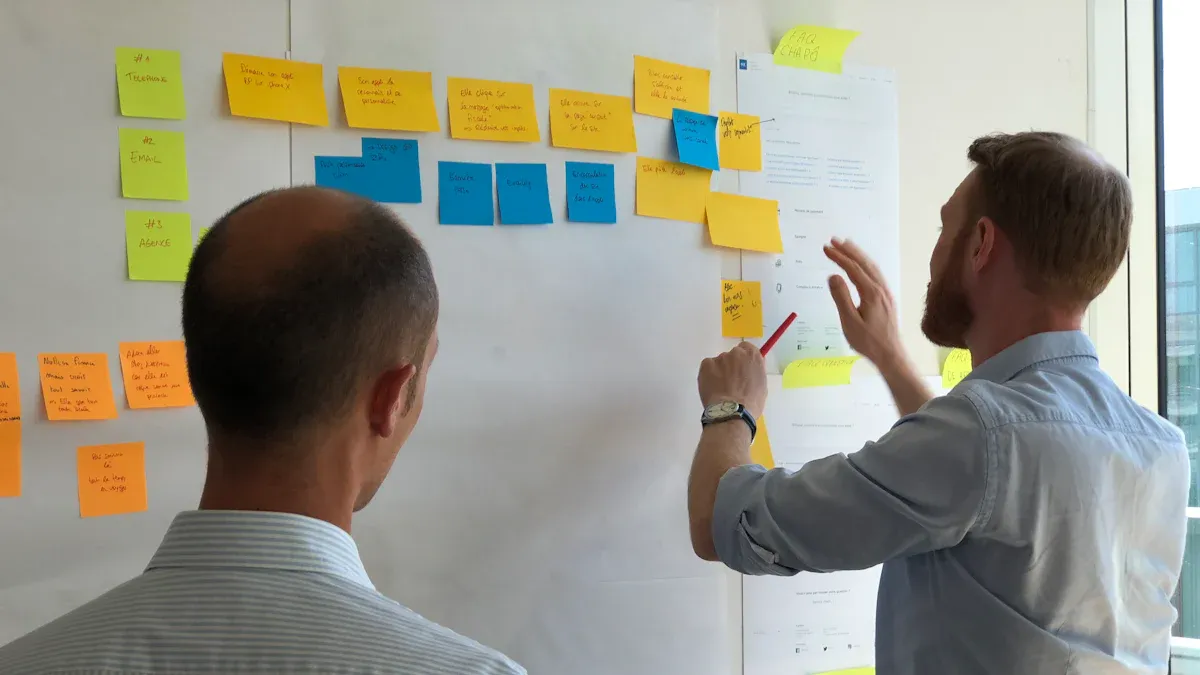Customer journey vs customer experience mapping is key to great customer experiences in 2025. As people expect more, businesses must create personal connections. Studies show 88% of companies see the value of personalization. However, many still struggle to improve online customer journeys. Also, 73% of customers may leave brands after bad experiences. To fix this, businesses need to know the difference between journeys and experiences. They also need tools to turn messy interactions into smooth, loyalty-building moments. Explore HeroDash Pricing Plans to learn how advanced tools can help.
Customers who get personalized experiences spend 140% more. This shows personalization is a must for business success. See Our Full Pricing and Get your free quote now to start enhancing your customer interactions today.
Understanding Customer Journey vs Customer Experience
What Is a Customer Journey?
A customer journey is the path you follow with a business. It covers all steps, from finding a product to becoming loyal. These steps—Awareness, Consideration, Purchase, Retention, and Advocacy—form a loop. Each step builds on the last, shaping your bond with the brand. For instance, visiting a website starts your journey with awareness. Every click, question, or purchase adds to this path. Businesses use maps to study these steps and improve how they guide you.
What Is Customer Experience (CX)?
Customer experience is about how you feel when dealing with a business. It focuses on emotions and thoughts at every step. Whether chatting with support or browsing online, CX shows the quality of those moments. Good experiences make you feel special, while bad ones frustrate you. For example, quick replies make you happy, but delays upset you. Businesses track CX with tools like CSAT, NPS, and CES to meet your needs.
Key Differences and Why They Matter for Your Strategy
Customer journey and customer experience are linked but different ideas. The journey tracks your steps, while CX focuses on your feelings. For example, journeys measure clicks and traffic, while CX checks satisfaction and loyalty. Aligning both helps businesses handle practical and emotional parts of your experience.
Aspect | Customer Journey | Customer Experience |
|---|---|---|
Definition | Steps you take | How you feel |
Focus | Stages, actions | Emotions, thoughts |
Key Metrics | Clicks, traffic, funnels | CSAT, NPS, CES |
By knowing the difference, businesses can plan better. They guide you smoothly and make you feel important. This boosts loyalty, happiness, and keeps you coming back.
The Importance of Customer Journey Mapping

Making Customers Happier with Clearer Journeys
Knowing your customers’ journeys shows how they interact with you. This helps you see what works and what doesn’t. For example, tracking steps shows where they’re happy or stuck. Fixing these problems makes their experience better.
Studies say businesses using journey tools get higher satisfaction scores. These tools track things like Customer Satisfaction Score (CSAT) and Net Promoter Score (NPS). Checking these often helps you meet customer needs. When you improve problem areas, customers enjoy smoother experiences and return more often.
Tip: Use tools like HeroDash to follow customer actions on all channels. Spot patterns and make smart choices based on data.
Finding Problems and Missed Chances
Friction points are spots where the journey goes wrong. These include long waits, tricky checkouts, or unclear info. Finding these issues is key to boosting sales.
For example, many leave carts during checkout due to high shipping costs or few payment options. Watching user actions helps you fix these, like adding free shipping or more payment choices. Research says fixing these can cut cart drop-offs by 27%.
Missed chances happen when you don’t connect with customers at key moments. Mapping the journey shows these gaps so you can act. Sending follow-ups or discounts can make a big impact.
Making Experiences Personal with Journey Data
Personalization is now expected by customers. They want things that match their needs. Using journey data helps you give them this.
For instance, real-time data can predict what customers want next. Smart tools like Bayesian models use data to suggest products or services. Businesses using these see 38% better engagement and sales.
Personalization also fixes problems faster. If a customer struggles, you can offer specific help. This improves their experience and builds loyalty. Tools like HeroDash combine data from all channels, making every interaction smooth and personal.
How to Create a Customer Journey Map

Understand Your Customers and Their Goals
Start by knowing who your customers are and what they want. Create customer personas, which are profiles of your ideal customers. These personas include details like age, goals, and problems they face.
Component | Description |
|---|---|
Goals and motivations | Learn what customers aim to achieve in life or work. |
Pain points and challenges | Find out what frustrates them and how you can help. |
Knowing customer goals helps you match their needs with your business plans. For example, if a customer wants quick help, focus on fast support. Listing these goals keeps your map focused on helping customers and growing your business.
Tip: Work with your teams to gather ideas about customer needs. Teams like sales and support often know what customers want.
List All Customer Interactions
Write down every way customers connect with your business. These are called touchpoints, like visiting your website or emailing support.
Using templates can make this easier. Templates help organize touchpoints, metrics, and key moments. This ensures you don’t miss important steps in the journey.
Add metrics to each touchpoint to track how well it works.
Show these metrics clearly on the map for easy understanding.
Check the data often to fix weak spots and improve results.
Touchpoint mapping isn’t done just once. Update it regularly based on customer feedback. This keeps your map useful and helps improve customer experiences over time.
Study Feelings, Problems, and Intentions
Customer journey mapping isn’t just about actions—it’s also about feelings. Look at emotions, pain points, and intentions at every step.
Track feelings at each touchpoint to spot happy or frustrating moments.
Solve big problems like long waits or confusing websites.
Use metrics to see how changes affect customer satisfaction and loyalty.
For example, if customers feel annoyed during checkout due to few payment options, fixing this can boost sales. Measure success using metrics like retention and satisfaction rates. By focusing on emotions and intent, you can make the journey smoother and more enjoyable.
Note: Tools like HeroDash can help you study customer feelings and actions across different channels. This makes it easier to offer personalized and thoughtful experiences.
Use Visual Tools to Share the Journey with Your Team
Visual tools help your team understand the customer journey better. They turn hard-to-read data into simple, clear pictures. This makes it easier for everyone to focus on customer needs.
Charts and dashboards are great for spotting patterns in customer actions. They show trends, emotions, and problem areas. For example, a chart of satisfaction scores can show where customers struggle. This helps your team fix the most important issues.
Here’s why visual tools are helpful:
They show key steps in the customer journey.
They explain customer feelings and actions clearly.
They help teams work together toward shared goals.
Tool Name | What It Does | Why It Helps |
|---|---|---|
Tool 1 | Shows customer actions visually | Finds problems and improves communication |
Tool 2 | Tracks feelings and actions | Boosts satisfaction and loyalty |
Tool 3 | Adds customer feedback | Updates plans based on real experiences |
These tools make it easy to share the customer journey with your team. For example, showing customer actions visually can highlight issues. Tools that track feelings can help keep customers happy. Adding feedback to visuals improves plans and matches real needs.
When teams see the journey visually, they work better together. Each group learns how their work affects the big picture. This teamwork helps your business create smoother journeys for customers.
Tip: Use tools like HeroDash to see all customer actions in one place. These tools help you build better maps and improve customer experiences.
Using Technology and Understanding Feelings in Journey Mapping
Tracking and Predicting Behavior with Data
Data helps you see how customers act and what they need. By studying data from different places, you learn about their likes, dislikes, and feelings. This helps you create better plans to meet their needs.
Predictive tools go further by spotting patterns in behavior. For example, smart tools can suggest items based on what someone bought before. This makes shopping easier and builds stronger customer relationships.
Real-time data helps fix problems fast. If a customer gets stuck during checkout, you can quickly make changes. Quick fixes like these make customers happy and keep them coming back.
HeroDash: A Tool for Seeing the Whole Journey
HeroDash by Callnovo makes mapping customer journeys simple. It connects with social media, email, phone, and chat to track all interactions. This shows where things can improve for a smoother experience.
HeroDash lets you see what customers do and feel right away. For instance, if someone has trouble on social media, HeroDash alerts your team to help quickly. This reduces problems and makes customers happier.
The tool also shows trends in customer actions. These insights help you give personal service and guess future needs. Using HeroDash turns messy experiences into smooth ones, building trust and loyalty.
Adding Empathy to Make Better Journeys
Understanding feelings is key to making great customer journeys. When you notice how a customer feels, it improves their experience. For example, if a support agent sees someone is upset, they can show care and solve the problem. This builds trust and loyalty.
Studies show that customers who feel connected to a brand stay longer. They are also more valuable to the business. Brands that focus on emotions, not just fixing problems, keep more customers.
To use empathy, find moments when customers might feel stressed. Offer clear help, like easy instructions or personal suggestions. This reduces frustration and makes the journey better. By caring about feelings, you create stronger connections with your customers.
2025 Trends: Predictive Mapping, Real-Time Changes, AI Tools
Predictive mapping, real-time changes, and AI tools are reshaping customer journeys in 2025. These trends help businesses predict needs, act fast, and improve experiences.
Predictive Mapping: Guessing What Customers Will Do
Predictive mapping uses data to guess customer actions and likes. It helps businesses make better choices by studying patterns. For example:
Predictive tools keep products ready when customers want them. This avoids delays and increases sales.
In factories, predictive tools stop machines from breaking, saving money and time.
Using predictive tools lets businesses solve problems before they happen. This builds trust and keeps customers interested.
Real-Time Changes: Fixing Problems Right Away
Real-time changes let businesses react quickly to customer needs. By 2025, edge computing will handle most business data instantly. For example:
If a customer has trouble checking out, real-time tools can fix it fast.
Quick fixes, like changing delivery options or giving suggestions, make customers happy and reduce issues.
These changes create smooth experiences and show customers their time matters.
AI Tools: Making Work Faster and Smarter
AI tools are changing how businesses map customer journeys. Machine learning is growing fast, improving predictions and decisions. Benefits include:
AI helps plan projects better by studying past data.
It improves how resources are used, meeting customer needs faster.
HeroDash uses AI to give instant insights across channels. It helps businesses personalize service and solve problems quickly. AI handles big data, keeping customer journeys smooth and flexible.
By using these trends, businesses meet customer expectations and build loyalty for the future.
Best Practices for Updating Journey Maps
Keep Maps Fresh with Feedback and Market Changes
Customer journey maps need updates as needs and markets shift. Regular reviews help find gaps and fix problems in touchpoints. Monthly or quarterly checks catch issues early and show new chances.
Customer feedback is key to improving journeys. It shows where changes can make a big difference. For example, feedback from checkout pages or support chats can reveal problems. Fixing these areas makes customers happier and more satisfied.
Modern tools like AI make updates easier and faster. AI studies big data to create better experiences quickly. Businesses using AI see 30% more customer loyalty and 20% higher satisfaction. This keeps maps useful in a fast-changing world.
Work Together Across Teams
Teamwork makes journey mapping stronger. Involve CX, marketing, sales, and product teams for better ideas. Each team offers unique views to understand customers better.
For example, marketing can improve messages at key points. Sales can point out problems in buying steps. CX teams share customer feedback, and product teams suggest fixes based on user actions. This teamwork creates a plan that balances practical needs and emotions.
Review maps often with input from all teams. This keeps them updated with customer habits and business goals. Working together improves customer experiences and builds better teamwork.
Match Maps to Goals and Customer Values
Journey maps should fit your business goals and customer focus. Linking maps to plans boosts satisfaction, loyalty, and growth. Fixing issues from maps helps you deliver great experiences.
A customer-first mindset leads to smarter choices. For example, matching touchpoints to customer needs helps you focus on what matters most. Companies using this approach see big improvements in loyalty and happiness.
To align maps, learn what customers want and expect. Use maps to find where your values meet their needs. This creates a guide for giving both emotional and practical value. Keeping maps tied to goals builds trust and long-term success.
Customer journey mapping is now a must for great experiences in 2025. Businesses that focus on mapping customer steps see big improvements. These include better satisfaction, loyalty, and keeping customers longer. For example, brands like Nike and Apple made their processes easier. This led to happier customers and stronger loyalty to their brands.
Mapping customer steps also shows important moments that affect loyalty. It helps find problems, key steps, and links between feelings and actions. This way, you can create journeys that grow with your business and connect emotionally with customers.
Company | What They Improved | Results |
|---|---|---|
Nike | Made online orders simple, improved stock levels | Happier customers |
Apple | Made returns easy, better in-store experience | Better overall customer experience |
Now is the best time to focus on customer experience design. Use customer journey maps to make smart changes. By collecting feedback and using tools like HeroDash, you can match your plans to customer needs and build strong loyalty.

